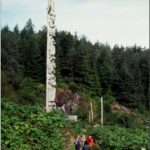 After a summer of cruising the waters off the east coast of Vancouver Island in search of history, I traversed the island on a hot and sunny September day, and headed to the west coast with several members of the Captain Cook Society; this time in search of the site where Cook landed in March of 1778.
After a summer of cruising the waters off the east coast of Vancouver Island in search of history, I traversed the island on a hot and sunny September day, and headed to the west coast with several members of the Captain Cook Society; this time in search of the site where Cook landed in March of 1778.
The trip was instigated by an enterprising fellow by the name of Randy Komar, who in March this year, held the first formal meeting of the West Coast Captain Cook Society in Courtenay.
The Society itself http://www.captaincooksociety.com, has been in existence for several years, with various chapters throughout the world – in fact, anywhere that Cook travelled, but there wasn’t a group on Vancouver Island, even though Cook had visited its shores. Randy thought he would correct this oversight, assuming that there must be a number of ‘Cookies’ as Cook fans are affectionately known, in our vicinity.
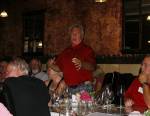
In all, 29 people joined together on this expedition to see the place where Cook arrived in HMS Resolution at Nootka Sound, the site of the historic meeting between Cook and the chief of the Mowachat Nation, Chief Maquinna. The meeting is believed to have been the first contact between these natives of British Columbia and Europeans. As the Mowachat were eager to trade with the British sailors, this resulted in Cook being given a number of sea otter pelts which unbeknown to him would precipitate an avalanche of trade over the next 25 years, effectively wiping out the northwest coast sea otter population.
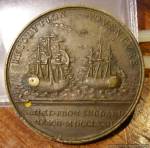
Our group met for dinner in Gold River and the first people I saw were Leona and Don who I knew from the BC Historical Federation Conferences and Bonnie and Maureen, who had been on the Museum’s Thurlow Islands trip that I was interpreter for. Of course, like minds!
At Randy’s suggestion, after dinner several of the members introduced themselves and explained how they had come to be interested in the intrepid Cook. One couple had come all the way from New Zealand to share in the adventure – a numismatist (a numismatist is a type of coin collector) Graeme Brown and his wife Avis. Graeme had brought with him a fascinating and rare medal called the Resolution and Adventure medal. The medals were struck by Joseph Banks, the famous naturalist who had travelled with Cook, and the 2000 pieces made were meant to be distributed anywhere that Cook travelled. Some have been recovered from around the globe; eight are known to exist in New Zealand, and one was found on Nootka Island.
All present had a different reason for being interested in Cook – some were like Melanie Bagley of Courtenay who hadn’t thought much about Cook since high school, but was eager to learn more from the well informed group. Other attendees came from Campbell River, Quadra Island, the Comox Valley, Victoria, the BC mainland, and California. We spent the night at the Ridgeview Motel, then travelled down the next morning in time to catch the 10:00am departure of the Uchuck III from the Gold River dock. Much to our surprise and delight, Captain Cook (aka Alberto) was there in person! Many of us eagerly took photos and had our photos taken – a once in a lifetime opportunity! What an auspicious way to begin our journey!
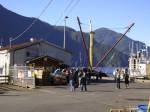
On that happy note, we boarded the vessel – in itself an important piece of coastal history documented in David Esson Young’s book, ‘The Uchuck Years’. It was Young’s father who founded the Uchuck coastal freighter service. I hadn’t been aboard the Uchuck in 12 years, and was very gratified to see that they were continuing in the tradition of serving good wholesome food and home baking, thanks to Elaine, the cook.
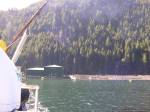 I was also pleased that Chuck Syme was on board – an extremely knowledgeable historic interpreter from Gold River, who was available to answer any questions passengers on the Uchuck might have about the history of the area we were passing through, and the history we had yet to encounter. We stopped at a fish farm to unload supplies, and that brought back memories of a fun time I had had staying with my son Jean-Luc at the site he worked at in the Muchalat Inlet next to Bligh Island seven years earlier.
I was also pleased that Chuck Syme was on board – an extremely knowledgeable historic interpreter from Gold River, who was available to answer any questions passengers on the Uchuck might have about the history of the area we were passing through, and the history we had yet to encounter. We stopped at a fish farm to unload supplies, and that brought back memories of a fun time I had had staying with my son Jean-Luc at the site he worked at in the Muchalat Inlet next to Bligh Island seven years earlier.
It was a full boat – 99 people, and our group and everyone else had plenty of time to mingle and visit, enjoy the food
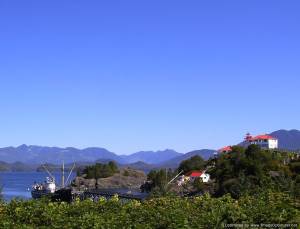
and scenery and take pictures. We came out of the Inlet and around the top end of Bligh Island and as we cruised down the Sound, the iconic lighthouse at Yuquot/Friendly Cove came into view. Just as we were getting off the boat, I began a conversation with a lady named Berthe who told me she had lived at Greene Point Rapids, where I go each summer to a family cabin. How auspicious! Here was an opportunity to add to that history that has been an ongoing part of my research for the last eight years.
But we were here to learn more about Nootka Island, and Margarita James from the Mowachaht Band, had travelled over with us so that she could welcome visitors to the Island and explain its overall history. Inside the little white church with its astonishing totems and the stained glass windows presented by the government of Spain, the shared story of the native inhabitants and the European visitors was 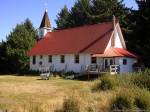 told. The church itself had been built in 1954, after the original church constructed in the late 1890s by a Belgian priest by the name of Father Brabant had burned down. (Brabant was intent on educating the native people in European ways, and was responsible for starting residential schools.)
told. The church itself had been built in 1954, after the original church constructed in the late 1890s by a Belgian priest by the name of Father Brabant had burned down. (Brabant was intent on educating the native people in European ways, and was responsible for starting residential schools.)
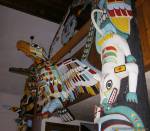
The Mowachaht lived on Nootka Island until the early 1960s when it was becoming more difficult to live a traditional lifestyle and work had to be found elsewhere. Almost the entire band, which by this time had amalgamated with the Muchalat Nation who inhabited the Inlet and Gold River, was relocated to Gold River to reserve lands near the dock and former mill site.
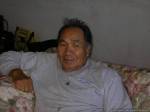
Only two people remained on Nootka Island and still live there today, guardians to the sacred landscape, their centre of the world – Ray and Terri Williams. Their son Sanford, a master carver, resides with them there in summer where he produces astonishingly beautiful pieces from his carving shed located on the beach, just below the William’s house.
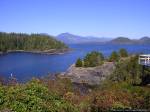
After Margarita’s welcome, we took a group picture then disbursed in different directions. Some of us joined Chuck on a walk up to the lighthouse, from where we could view the Cook memorial*, sitting right at the southern point of the island. All too soon, it was time to go back to our ship. We were given a special treat though – once we were underway, the skipper took us around the west side of the island, which I had never before seen from the water. Then we left the Sound to head back up the Inlet, slowing down to view the plaques that had been put into place in the 1970s to commemorate Cook’s stay at Blight Island where his ship Resolution had undergone a refit.
It couldn’t have been a more perfect day and I think many of us felt grateful to Randy for instigating this adventure and bringing together such a diverse group of people who were united in a fascination with the adventures of Captain James Cook.

*For an interesting article on the Cook Memorial from the BCHF read here
